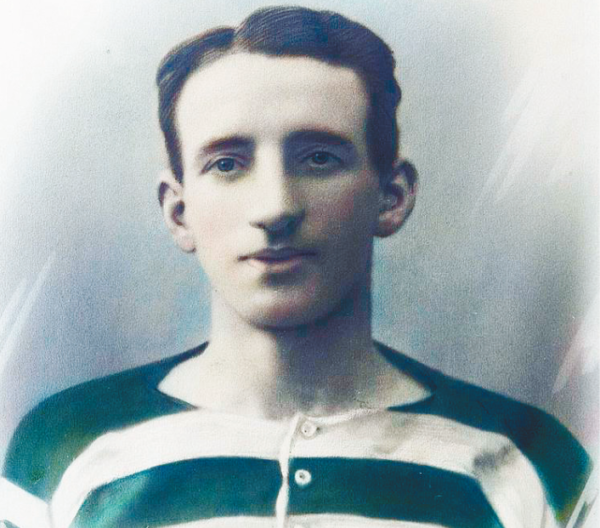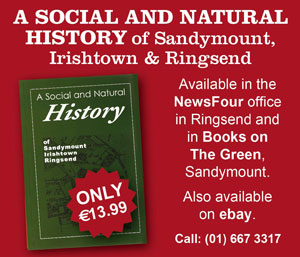
Gavan Bergin
The 1925 Cup was the last trophy Patsy won with Celtic. After playing the 1925/26 season with them he was not offered another contract. Apparently, the Celtic board wanted to save on his wages, which were the highest of any player at the club, and as Patsy was 35 his best years were supposedly behind him. After fifteen years as a Celtic player in which time he had scored 196 goals in 464 matches, won eleven major trophies and sealed his status as one of the all-time great players at Celtic they sold him to Falkirk for £1500 in October 1926.
It turned out they made a mistake by not keeping Patsy. He played first class football for his new team during six fine seasons between 1926 and 1932, the very years when Celtic could really have done with Patsy to help them hold back the mighty Rangers, who became the kings of Scottish football by winning the League five times in a row after Patsy’s departure from Celtic in 1927
Patsy spent the rest of his career happily playing at Falkirk, and he was just as much of a favourite there as at any of the other teams he played for. He played his last professional game at the age of 41 during the 1931/32 season, at the end of which he retired from football. In his time with Falkirk, he scored 34 goals in 169 matches. He scored 196 goals in 464 matches for Celtic. A total of 230 goals in 633 matches during his twenty years playing in the top division of the Scottish League.
Patsy also had a long international career that spanned from 1919 to 1931. He made his debut for Ireland against England in Belfast on October 25th 1919, wearing the shamrock-crested St Patrick’s blue jersey that the Ireland team wore back then. Patsy was good in that match, he was perfectly at home in international football. Playing a different role than he did for his club, he concentrated on supporting the attack rather than going for goal himself. He provided a real test for the English defence, time and again he tore it open and made space for his teammates in the forward line. His classy performance helped Ireland secure a hard-fought draw, a result that extended their unbeaten run against England to three matches, which was a highly impressive achievement considering the fact that at one time in the past, Ireland had lost as many as 12 consecutive matches against the English. Patsy won another ten caps for the Belfast based Ireland team, the last of which was in 1927. By then ‘the split’ had happened in Irish football, resulting in two national teams, north and south. Patsy, having been born in Donegal, was of course eligible for the new Irish Free State team as well as for the Northern team he had been playing for since 1919. He was duly selected by the Free State team for their first ever senior international match, against Italy in Turin on March 21st 1926, but in the end the team for that historic fixture consisted only of League of Ireland players. They lost the match by three goals to nil. Patsy might or might not have made the difference to that result but no one ever found out because Celtic, when they were asked to release Patsy for international duty, refused to do so, despite the importance of this match and the occasion to their Irish fans who had always been fervent, loyal supporters of the Glasgow club. Celtic declined and Patsy missed the game in 1926. He was selected again by the Free State for their next match, against Italy in Dublin in April 1927, but on that occasion he was injured and couldn’t play. In the end Patsy didn’t play for the Ireland until December 1931 when he made his debut against Spain. By then he was 40 years old and had reached the end of his long career, so that was his one and only cap. Less than six months later he retired from playing.
He finished his career as one of the most successful and popular players Scottish football has ever had. And as well as being idolised by football supporters, he had always been popular in the game, well liked by his teammates and even by those who were his fiercest rivals on the pitch. He was raised as a Roman Catholic and was undoubtedly a Celtic man through and through, but Patsy had no time for any of the bigoted sectarian nonsense of the ‘Old Firm’ rivalry of Celtic and Rangers. Far from hating Rangers and their players, Patsy was friendly with them, and one of his best pals was Andy Cunningham, the great forward for Rangers who scored hundreds of goals for them at the same time as Patsy was doing likewise for Celtic. Cunningham’s prolific scoring regularly helped Rangers deprive Patsy and Celtic of success-but that made no difference to the friendship between the two players. On one occasion that friendship led Patsy to do something so reckless and shocking it’s amazing he survived it at all. In April 1922, at Andy Cunningham’s benefit match a crowd of thousands was shocked to see Patsy walking out to play wearing the famous blue Rangers jersey! The hordes laughed in disbelief at the sight in front of their eyes: Patsy Gallagher, Glasgow Ranger. Of course he played a stunner of a game from first to last, and when the final whistle blew he started smiling to himself and all of a sudden he whipped off his jersey, causing another round of laughter when everyone saw that underneath the Rangers shirt he’d been wearing a Celtic one all along! The fans loved him no matter what, and Scotland loved him.
When Patsy retired from playing, he became the full-time landlord of the International Bar in Clydebank, which he had bought in 1925. Running the pub was an occupation that suited Patsy, who was as charming off the football field as he had been on it. He ran the pub for the rest of his days until his death in 1953.
The newspapers were filled with tributes to Patsy when he died, and every article and obituary was bursting with praise about him.
The Glasgow Herald said he was “one of the most gifted and talented players ever seen in the Scottish game. He looked nothing like a football player, but he was a superb gymnast, capable of unbelievable trickery and skills. He was a folk hero at Celtic.”
The Falkirk Herald hailed Patsy “a born entertainer whose football thrilled thousands, whose swarves made strong men clutch each other with joy and the other strong men gnash their teeth in anger as he dodged defenders with twinkling footwork. Wherever football was spoken (or drunk) Gallagher’s name, his wizardry and ball control was and still is one of the main topics of the conversation. He was a genius, a wizard, a man who could make a football do almost anything.”
In conclusion:
Patsy died in 1953, exactly 24 years after his wife, and he raised their six children on his own. He is buried in Arkleston Cemetery in Paisley. In 2007 a memorial plaque was unveiled to him in Ramelton which was attended by members of his family, locals, and some of Celtic’s Lisbon Lions team. Two of his sons, Tommy and Willie, also became footballers, as did his grandsons Brian and Kevin, Kevin going on to play for Scotland at the 1998 FIFA World Cup. Patsy Gallagher will always be loved and remembered by Celtic and Irish fans alike.



